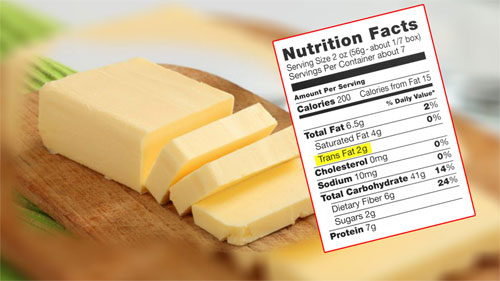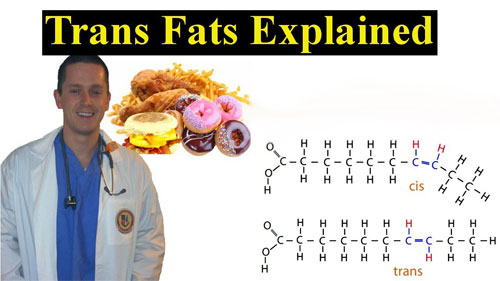Warning! These 8 Foods Are Still Made with Trans Fat

The majority of the foods you eat go through some kind of processing. Even fruits and vegetables go through very small amounts of processing before they hit grocery store shelves. The more processing a food goes through, the less healthy it is to eat.
The problem is, food manufacturers don’t make unhealthy ingredients very easy to detect. Many harmful ingredients are hidden in plain sight on food labels, you’ve just never been taught how to look for them. Trans fat just happen to be one of these stealthy specimens.
Of all the dangerous food additives out there, trans fat is possibly one of the worst. It’s so dangerous, in fact, that the Food and Drug Administration no longer recognizes it as safe for humans to eat. Though companies are gradually phasing it out of their products by law, it hasn’t all disappeared quite yet.
Let’s look at what trans fats are, why they are so harmful, where they might be hiding, and how to spot them.
What is trans fat, exactly?
To understand what trans fat is, it is important to know the different types of trans fat. There are two main types: natural trans fats, and artificial trans fats.
If you’ve ever looked at the nutrition information of an animal product, you’ve probably noticed it contains trans fats. However, these are natural trans fats. Animal products have them from the beginning, they aren’t added during any processing.
While they’re not great to eat in large amounts, they aren’t nearly as dangerous as synthetic or artificial trans fats.
Artificial trans fats are the type of fat you should avoid at all costs. To create these fats, manufacturers add hydrogen to vegetable oil. This makes the oil solid at room temperature (oil is usually liquid).
According to Mayo Clinic, companies use trans fat for several primary reasons. Trans fat keeps food from spoiling, giving it a longer shelf life. This is why trans fats used to be so common in processed foods. Restaurants also like to use oil containing trans fats in deep frying, because they don’t have to change it as often as regular vegetable oil.
For the rest of this article, when we talk about trans fat, we’re talking about the dangerous, artificial kind. Though all trans fats are harmful, artificial trans fats are significantly worse for your health.
Before we get into foods to avoid, let’s break down why exactly trans fats are so bad for you to eat.
Why is trans fat so bad for you?
You know what trans fat is. But what makes it as terrible as it sounds? This can seem confusing, because when people talk about fat in food, they almost always refer to your heart.
What’s tricky is that some types of fat are good for your heart, while others are your heart’s worst enemy. Let’s think of trans fat as your heart’s arch Nemesis. When it enters your body, it’s out to do some serious damage, damage that could eventually cost you your life.
Most consumers and many experts still blame saturated fats for a worldwide increase in rates of heart disease. They’re not the worst offenders, however. Trans fats win that prize.
According to research, all types of trans fat can raise your risk of developing heart disease. Even if you limited your saturated fat intake, but still ate large amounts of trans fat, you’d still cause major damage to your heart. Here’s how.
Trans fat and your heart

You have two types of cholesterol: good cholesterol, and bad cholesterol. Good cholesterol’s job is to pick up the extra bad cholesterol in your blood and take it to your liver.
The more bad cholesterol you have, the harder good cholesterol’s job becomes. Guess what happens when you eat foods containing trans fats? Your bad cholesterol levels go up.
When that happens, the bad cholesterol, which your good cholesterol can’t clean up fast enough, builds up in your arteries. The substance that builds up in your arteries, mostly made up of cholesterol and fat, is called plaque. Since your good cholesterol can’t keep your arteries clear, plaque buildup gets worse and worse. Left untreated, you could have a heart attack, or a stroke.
Eating fewer foods containing trans fats is one of many ways to keep your heart healthy. The good news is, even though trans fats are terrible for you, you won’t have to worry about them much longer.
The future of trans fat
It’s probably really unsettling, realizing that foods still contain an ingredient as dangerous as trans fat. How could they do this to us? Why do these chemicals still exist? Thankfully, our days of worrying about these horrific fats are nearing their end. Experts and government officials realize how damaging these fats can be. So they’re removing them, for good.
In 2015, the United States Food and Drug Administration announced that trans fats no longer qualify as generally recognized as safe. “Generally recognized as safe” foods often include additives that science hasn’t proven harmful yet. As noted above, science has proven the dangers of trans fats more than once. Therefore, in the near future, you won’t be able to find trans fats in foods even if you try. It’s now a law that manufacturers need to stop using them.
Until all trans fats are officially removed from our food, though, you still have to keep close watch on certain products. Here are a few trans fat-containing foods you should stay away from.:
Doughnuts
Lovers of glazed, fried dough, you’re about to hear some news you’re not going to like. If you’ve ever eaten a glazed doughnut from Krispy Kreme, you know how delicious (and non-nutritious) these circular slices of “heavenˮ are.
Unfortunately, they’re even worse for your health than you thought. Every glazed doughnut from good old-fashioned Krispy K contains trans fats. In particular, these doughnuts contain partially hydrogenated cottonseed oil. It’s used in shortening during baking to produce the doughnut-like texture you’re expecting. You might want to rethink your breakfast choice next time you’re stopping for something on the go.
Frozen microwave dinners
Many people buy frozen microwave meals for the convenience, even though they tend to cost a lot per box. You might want to consider spending your money on food that won’t clog your arteries, though.
Certain frozen dinner brands, like Hungry Man, still sell meals made with trans fats. In cases like these, the company adds trans fats to help preserve the frozen food inside each box. A frozen dinner can sit in the freezer for a long time before you have to throw it out. That’s probably not a good sign.
Pancake and waffle mixes
Pre-made waffle and pancake mixes are super convenient. The flavored ones taste great, too. You should generally watch out for foods flavored artificially, though.
Hungry Jack pumpkin spice mixes bring everyone’s favorite season right to your table, for example. Unfortunately, that comes with a cost: trans fat. Their regular mixes don’t have it, which implies it’s all in the flavoring.
If you want pumpkin spice-flavored waffles or pancakes, it’s probably a good idea to make your own from scratch. Convenience and deliciousness really aren’t worth the risk.
yogaesoteric
October 1, 2018
